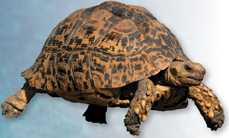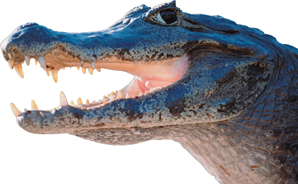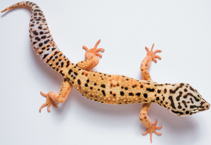There are nearly 9000 species of reptiles (not including birds).
SPHENODONTA: Tuataras
The tuatara, found only on a few small islands off the coast of New Zealand, is the only living member of this group. Tuataras resemble lizards in some ways, but they lack external ears and retain primitive scales.

Tuatara
SQUAMATA: Lizards, snakes, and relatives
There are more than 8000 species of lizards and snakes. Most lizards have legs, clawed toes, and external ears. Some lizards have evolved highly specialized structures, such as glands in the lower jaw that produce venom. Snakes are legless; they have lost both pairs of legs through evolution. Examples: iguanas, Milk Snake, Coral Snake

Leopard Tortoise
ARCHOSAURS: Crocodilians; pterosaurs and dinosaurs (extinct); and birds
This clade includes some of the most spectacular animals that have ever lived. The extinct dinosaurs and pterosaurs (flying reptiles), whose adaptive radiations produced some of the largest animals ever to walk Earth or fly above it, are the closest relatives of birds. Living crocodilians are short-legged and have long and typically broad snouts. They are fierce carnivorous predators, but the females are attentive mothers. Crocodilians live only in regions where the climate remains warm year-round. We discuss birds separately. Examples: extinct types: Tyrannosaurus, Pteranodon; living types: alligators, crocodiles, caimans, and birds (see following pages)

Paraguay Caiman
TESTUDINE: Turtles and tortoises
Turtles and tortoises have a shell built into their skeleton. Most can pull their heads and legs into the shell for protection. Instead of teeth, these reptiles have hornlike ridges covering their jaws equipped with sharp beaklike tips. Strong limbs can lift their body off the ground when walking or, in the case of sea turtles, can drag their body across a sandy shore to lay eggs. Examples: snapping turtles, green sea turtles, Galápagos tortoise

Leopard Gecko
Table of Contents
- Formulas and Equations
- Applying Formulas and Equations
- Mean, Median, and Mode
- Estimation
- Using Measurements in Calculations
- Effects of Measurement Errors
- Accuracy
- Precision
- Comparing Accuracy and Precision
- Significant Figures
- Calculating With Significant Figures
- Scientific Notation
- Calculating With Scientific Notation
- Dimensional Analysis
- Applying Dimensional Analysis




